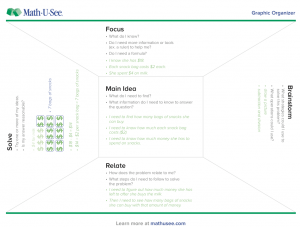Teach Word Problems with a Graphic Organizer [Free Download]

Word Problem Challenges
Many students love to read stories, play with puzzles, and creatively approach problems in their everyday life, so why do they have such an aversion to math word problems?
Word problems often pose a challenge because they require reading and comprehending the text of the problem, identifying the question that needs to be answered, and finally creating and solving a numerical equation.
If your student answers a word problem correctly, you assume he has a grasp of the concept. However, if it’s incorrect, you are left with many questions:
• Does he realize the answer doesn’t make sense?
• Did he not understand the context?
• Did he simply compute all the numbers in some way just to finish?
• Did he truly not know where to begin?
Most importantly: How can I help?
If you are lucky, you can identify the mathematical misconception and work from there. Oftentimes, however, the student’s answer isn’t even reasonable, and it can be difficult to pinpoint the exact area of his confusion. Then what can you do? If you find it challenging to teach your child how to solve word problems, try one or more of the suggestions below to help your student gain confidence in his problem solving skills.
Word Problem Strategies
Be More Relaxed & Playful
If your student has anxiety about word problems, try approaching them in a more relaxed and playful way by presenting problems that have more than one right answer, like a math puzzle or game. This can relieve the pressure of having to find “the right answer” and place the emphasis on the problem solving skills.
For example, consider this word problem: Shawn had $156. He went shopping for new hockey skates and now has $12 left. Find the cost of Shawn’s new hockey skates.
You can revise the problem to something like: The answer to a subtraction problem is 12. Tell what the equation might be.
The second question gives your student a springboard to work from, since it already indicates the operation. It also allows her to begin at her level of numerical comfort. In addition, because there are many answers to this type of problem, you can discuss with her how she went about solving it and gain some insight to her conceptual understanding and the strategies she used.
As an extension, you can ask her to write a word problem to match the math problem she created. These techniques can help her build confidence in her problem solving abilities and provide insight to you as to how she approaches solving a problem. Gradually she can work up to solving more problems like the first one presented above.
Extract the Numbers
Another way to increase comfort with word problems is to extract the numbers – in other words, create “numberless” problems. This is a great way to help your student notice the relationships in a problem and to observe how the language can help him understand those relationships.
For example, think about a problem such as: There are 125 girls participating in a choral competition. Twenty-nine more boys than girls are participating. Find the number of boys in the choral competition. Extract the numbers so it reads: Some girls are participating in a choral competition. More boys than girls are participating.
Then discuss with your child how he could find the number of boys participating in the choral competition.
By doing this you are helping him to focus on the situation of the problem, which will lead him to the necessary computation. He can insert his own numbers, or you can slowly introduce the numbers back into the problem for him to work with when he is ready to test a strategy. This method can also help your student determine when a problem contains extra information that is not necessary for solving the problem.
Graphic Organizer Example
Representing the information in the math problem with manipulatives, a drawing, or a diagram can also help make sense of the situation.
For example: Sara has 15 grapes. How can she divide the fruit between herself and two friends evenly?
Your student can show the 15 grapes with cubes or other small objects to represent the grapes and move them into three groups to find the answer. Discuss with your child how the picture, diagram, chart, expression, or equation relates to the situation in the problem. Ask her to explain why she chose it or why she thinks it is a good mathematical expression to use for the problem.
A graphic organizer can help develop the habit of visualizing a problem in smaller chunks. This can help shape your student’s thinking strategies to begin to think about where to start the problem solving process. Graphic organizers can also aid in brainstorming different thoughts and ideas as well as analyzing and synthesizing the mathematical concepts and procedures he selects to solve a problem.
Free Graphic Organizer Download
Click on the sample graphic organizer to see how it can be used to solve a word problem.

A blank version is also available for you to use with your student.
Word problems help your student to see math applied in the real world, and they encourage and give a reason to learn the underlying concepts and operations.
You can help your student make sense of these problems by helping and encouraging them with the problem solving processes. As your student moves forward in his mathematical learning, he will need to apply problem solving processes to more complex situations. By practicing on a regular basis, your child can strengthen and develop confidence in his problem solving skills.
We Are Here to Help
If you have questions about teaching math, we are here to help!
Get in Touch